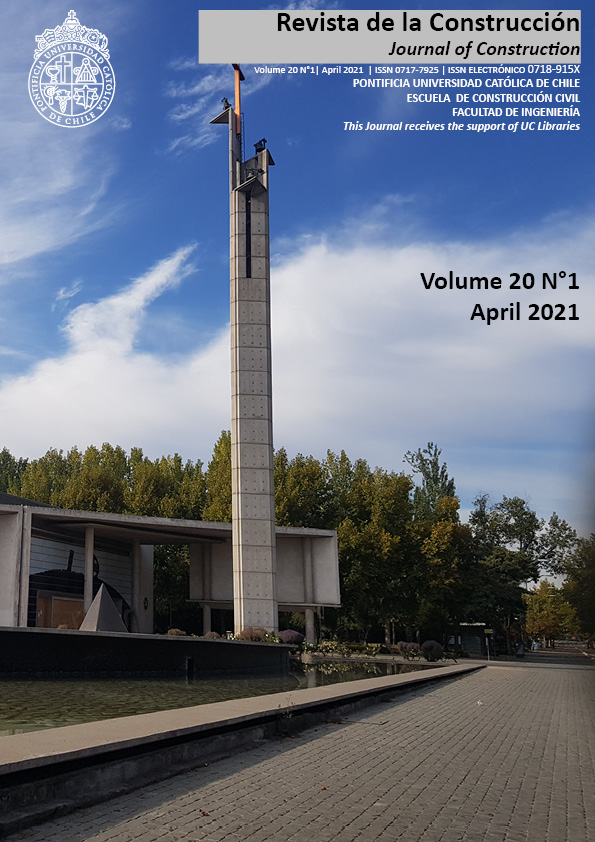Specimen size and shape effects on strength of concrete in the absence and presence of steel fibers
DOI:
https://doi.org/10.7764/RDLC.20.1.128Keywords:
size effect, steel-reinforced concrete, splitting tensile strength, compressive strength, shape effectAbstract
In this research, the effects of size and shape on compressive and splitting tensile strength of fibrous and non-fibrous concrete specimens with different characteristic strength were investigated. With this aim, both fibrous and non-fibrous 10 different concrete mixtures with 0.3, 0.4, 0.5, 0.6 and 0. 7 Water/Cement ratio were prepared. In the fibrous mixture specimens, the total amount of steel fibers to 1% by total volume. In the entire specimens, 42.5 R type Portland cement were used as bonding elements while crushed lime stones in 3 sizes were added to the mixtures. Furthermore, to evaluate the influence of size and shapes over specimens’ strength, for each concrete mixtures two 10 cm and 15 cm cubic specimen beside two 10×20 cm and 15×30 cm cylindrical specimens were prepared as well. The prepared specimens were subjected to compressive and splitting tensile tests. The results showed that, regardless of the fiber amount and specimens’ shapes, the decrease in specimens’ size resulted in higher strength. But in the high ratio of Water/Cement and fibrous mixtures, the mentioned behavior was not observed.
Downloads
References
Aitcin, P. C., Miao, B., Cook, W. D., & Mitchell, D. (1994). Effects of size and curing on cylinder compressive strength of normal and high-strength concretes. ACI Materials Journal, 91(4), 349–354. https://doi.org/10.14359/4044
Alex, X. I., & Arunachalam, K. (2019). Flexural behavior of fiber reinforced lightweight concrete. Revista de La Construccion, 18(3), 536–544. https://doi.org/10.7764/RDLC.18.3.536
Ashkari, H. (2015). Effect of geometry of concrete specimen on compressive strength [Master Thesies, Ege University, Graduate School of Natural and Applied Sciences, P 115]. https://tez.yok.gov.tr/ Aslani, F. (2013). Effects of specimen size and shape on compressive and tensile strengths of selfcompacting concrete with or without fibres. Magazine of Concrete Research, 65(15), 914–929. https://doi.org/10.1680/macr.13.00016
CEB-FIP MC10. (2010). Model Code 2010. In fib Model Code for Concrete Structures 2010. https://www.fib-international.org/
Che, Y., Ban, S. L., Cui, J. Y., Chen, G., & Song, Y. P. (2011). Effect of specimen shape and size on compressive strength of concrete. In Advanced Materials Research (Vol. 163, pp. 1375-1379). Trans Tech Publications Ltd.
Çopuroğlu, O. (2001). Specimen size and shape effect on compressive and tensile strength of concrete [Ege University]. https://tez.yok.gov.tr/
Dehestani, M., Nikbin, I. M., & Asadollahi, S. (2014). Effects of specimen shape and size on the compressive strength of self-consolidating concrete (SCC). Construction and Building Materials, 66, 685–691. https://doi.org/10.1016/j.conbuildmat.2014.06.008
Del Viso, J. R., Carmona, J. R., & Ruiz, G. (2008). Shape and size effects on the compressive strength of high-strength concrete. Cement and Concrete Research, 38(3), 386–395. https://doi.org/10.1016/j.cemconres.2007.09.020
Felekoğlu, B., & Türkel, S. (2005). Effects of specimen type and dimensions on compressive strength of concrete. Journal of Science, 18(4), 639–645.
Gyurkó, Z., & Nemes, R. (2020). Specimen size and shape effect on the compressive strength of normal strength concrete. Periodica Polytechnica Civil Engineering, 64(1), 276–286. https://doi.org/10.3311/PPci.15338
Khalilpour, S., & Dehestani, M. (2021). Enhanced specimen size and shape effect models for high-strength fibre-reinforced concrete. Proceedings of the Institution of Civil Engineers - Structures and Buildings, ISSN 0965-0911, 1–16. https://doi.org/10.1680/jstbu.19.00086
Köroglu, M. A., & Ashour, A. (2019). Mechanical properties of self-compacting concrete with recycled bead wires. Revista de La Construcción, 18(3), 501–512. https://doi.org/10.7764/RDLC.18.3.501
Li, M., Hao, H., Shi, Y., & Hao, Y. (2018). Specimen shape and size effects on the concrete compressive strength under static and dynamic tests. Construction and Building Materials, 161, 84–93. https://doi.org/10.1016/j.conbuildmat.2017.11.069
Mardani-Aghabaglou, A., İlhan, M., & Özen, S. (2019). The effect of shrinkage reducing admixture and polypropylene fibers on drying shrinkage behaviour of concrete. Cement, Wapno, Beton, 24(3), 227–238. https://doi.org/10.32047/CWB.2019.24.3.227
Neville A.M. (1995). Properties of Concrete. In Brithish library cataloguing in publication data (Fourth edi). Pearson education limited.
Ouedraogo, H. A., Özen, S., Kobya, V., Sagiroglu, S., & Mardani-Aghabaglou, A. (2021). Comparıson of fresh and hardened propertıes of self-compactıng concrete mıxture from dıfferent aspect ratıo of steel fıber vıew poınt. Journal of Green Building, 16(1), 115–138. https://doi.org/10.3992/jgb.16.1.115
Tokyay, M., & Özdemir, M. (1997). Specimen shape and size effect on the compressive strength of higher strength concrete. Cement and Concrete Research, 27(8), 1281–1289. https://doi.org/10.1016/S0008-8846(97)00104-X
TS EN 1097-6. (2013). Tests for mechanical and physical properties of aggregates- Part 6: Determination of particle density and water absorption. https://intweb.tse.org.tr/
TS EN 12350-2. (2010). Testing fresh concrete- Part 2: Slump test. https://intweb.tse.org.tr/
TS EN 14889-1. (2006). Fibres for concrete - Part 1: Steel fibres - Definitions, specifications and conformity. https://intweb.tse.org.tr/
TS EN 197-1. (2012). Cement- Part 1: Compositions and conformity criteria for common cements. https://www.scribd.com/
TS EN 206. (2014). Concrete- Part 1: Specification, performance, production and conformity. https://intweb.tse.org.tr/
Tuğal, M., & Arıcı, E. (2011). Investıgate of sıze effect ın geometrıc changes of splıttıng tensıle strenght of concrete. E-Journal of New World Sciences Academy, 6(4), 1086-1092. https://dergipark.org.tr/Yi, S.-T., Yang, E.-I., & Choi, J.-C. (2006). Effect of specimen sizes, specimen shapes, and placement directions on compressive strength of concrete. Nuclear Engineering and Design, 236(2), 115–127. https://doi.org/10.1016/j.nucengdes.2005.08.004
Zeynal, E. (2008). The effect of steel fiber and w / c ratios on impact strength and mechanical properties of steel fiber concretes [Ege Univeristy]. https://tez.yok.gov.tr/
Zhang, Y., Li, H., Abdelhady, A., Yang, J., & Wang, H. (2021). Effects of specimen shape and size on the permeability and mechanical properties of porous concrete. Construction and Building Materials, 266, 121074. https://doi.org/10.1016/j.conbuildmat.2020.121074





